Garry Winogrand: All Things Are Photographable
Directed by Sasha Waters Freyer
2018 / 90-minutes
A Greenwich Entertainment Release
at Film Forum, NYC
When Garry Winogrand died unexpectedly in 1984, he left behind over 2,500 undeveloped rolls of film. Garry Winogrand: All Things Are Photographable, directed by Sasha Waters Freyer, is a fascinating documentary that examines the quiet life of one of America’s most prominent postwar photographers, setting that in contrast to the professional career he had been most known for. As a stringer who worked primarily for mass-print magazines such as LOOK and LIFE, Winogrand has long been associated with prominent subjects such as Marilyn Monroe, Mohammed Ali and John F. Kennedy. However, this film’s vast number of interviews — which include his first wife Adrienne Lebeau, Thomas Roma, Jeffrey Fraenkel, Todd Papageorge, Jeffrey Henson Scales, Shelley Rice, Laurie Simmons and Matthew Weiner — show Winogrand as someone who enjoyed his own invisibility while rendering serendipitous inconsistencies.
Winogrand’s early distaste of photojournalism’s shallow nature was almost prophetic, since none of it made New York City a better place for very long. World War II was followed by the Korean War in the early 1950s while the 1960s was an era of recovery before New York City descended into economic and racial chaos. Winogrand found refuge in Austin, Texas and turned away from the spectacle in order to question the function of photography in a spectacle-dominant world. Garry Winogrand: All Things Are Photographable opens in 1975 with Winogrand presenting a carousel of black-and-white slides to a room of students, asking: “What is a photograph?” Shortly after he provides the answer, “the illusion of a literal description of how a camera [selects] a piece of time and space,” the film returns to a different era, about twenty years prior, when he was still living in New York City.
Winogrand came into photography quite naturally, in an era when galleries did not carry much heft for artists’ careers. Unlike the strong emphasis on validation today, photographers and artists in the late 1950s defined themselves by taking initiative to pursue their search for meaning. Winogrand grew up in the Bronx during the early 1930s, as a child of immigrants. By the time he took up photography, he had established himself comfortably as an outsider who roamed fluidly within the society that he lived.
The distance between the Bronx and the center of Manhattan was certainly a factor that contributed to the artist’s self-perceived status as an outsider. However, Matthew Weiner highlights the plight of assimilated Jews in New York City who — like the Winogrand’s — sought prosperity and advancement as it related to their professions. Within this ongoing context, Garry Winogrand easily adopted a point of view from the margins, a space where he enjoyed being both autonomous and invisible. In describing his method, Winogrand said that he always carried two cameras. In searching for a subject, he would often walk past a scene before turning around to take a picture. . .
To read the rest of Connor’s review, go to Riot Material magazine: https://www.riotmaterial.com/garry-winogrand-all-things-are-photographable/
And please follow us on Facebook: https://www.facebook.com/riotmaterial/
